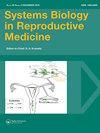精液质量对比种马精浆的高通量深层蛋白质组学分析
IF 2.1
4区 医学
Q3 ANDROLOGY
引用次数: 2
摘要
摘要精浆蛋白和与精子运动相关的途径尚未在种马中阐明。因此,在目前的研究中,使用高通量LC/MS-MS方法,我们对种马精浆蛋白进行了分析,并确定了与精子活力相关的蛋白和途径。六匹雄性种马的精浆产生的精液具有相反的精子活力(n = 高运动组和低运动组各3个)用于蛋白质组学分析。我们在种马精浆中共鉴定了1687种蛋白质,其中1627种和1496种蛋白质分别在种马的高(HM)和低(LM)精子中表达。在两组中共表达了1436种蛋白质;HM组和LM组分别检测到191种(11%)和60种(3.5%)蛋白质。与HM组种马相比,LM组种马的SP中共有220个蛋白质上调(变化>1倍),386个蛋白质下调,而两组中均有830个蛋白质中性表达。基因本体论和京都基因与基因组百科全书(KEGG)的分析揭示了在产生精子活力低的精液的种马的精浆中与线粒体功能、顶体和精子细胞骨架相关的重要蛋白质的失调。高丰度的过氧氧化还原酶和低丰度的含精伴侣蛋白TCP1复合物(CCT)和膜联蛋白表明氧化代谢失调,这可能是LM组种马精子运动能力差的潜在病因。总之,目前的研究确定了与种马精子运动能力差相关的精浆蛋白质组学改变;结果表明,种马精子活力低下可能与参与氧化代谢的精浆蛋白表达改变有关。本文章由计算机程序翻译,如有差异,请以英文原文为准。
High throughput deep proteomic analysis of seminal plasma from stallions with contrasting semen quality
Abstract Seminal plasma proteins and pathways associated with sperm motility have not been elucidated in stallions. Therefore, in the current study, using the high throughput LC/MS-MS approach, we profiled stallion seminal plasma proteins and identified the proteins and pathways associated with sperm motility. Seminal plasma from six stallions producing semen with contrasting sperm motility (n = 3 each high-and low-motile group) was utilized for proteomic analysis. We identified a total of 1687 proteins in stallion seminal plasma, of which 1627 and 1496 proteins were expressed in high- (HM) and low- motile (LM) sperm of stallions, respectively. A total number of 1436 proteins were co-expressed in both the groups; 191 (11%) and 60 (3.5%) proteins were exclusively detected in HM and LM groups, respectively. A total of 220 proteins were upregulated (>1-fold change) and 386 proteins were downregulated in SP from LM group stallions as compared to HM group stallions, while 830 proteins were neutrally expressed in both the groups. Gene ontology and Kyoto Encyclopedia of Genes and Genomes (KEGG) analysis revealed dysregulation of the important proteins related to mitochondrial function, acrosome, and sperm cytoskeleton in the seminal plasma of stallions producing ejaculates with low sperm motility. High abundance of peroxiredoxins and low abundance of seminal Chaperonin Containing TCP1 Complex (CCT) complex and Annexins indicate dysregulated oxidative metabolism, which might be the underlying etiology for poor sperm motility in LM group stallions. In conclusion, the current study identified the seminal plasma proteomic alterations associated with poor sperm motility in stallions; the results indicate that poor sperm motility in stallions could be associated with altered expression of seminal plasma proteins involved in oxidative metabolism.
求助全文
通过发布文献求助,成功后即可免费获取论文全文。
去求助
来源期刊
CiteScore
4.30
自引率
4.20%
发文量
27
审稿时长
>12 weeks
期刊介绍:
Systems Biology in Reproductive Medicine, SBiRM, publishes Research Articles, Communications, Applications Notes that include protocols a Clinical Corner that includes case reports, Review Articles and Hypotheses and Letters to the Editor on human and animal reproduction. The journal will highlight the use of systems approaches including genomic, cellular, proteomic, metabolomic, bioinformatic, molecular, and biochemical, to address fundamental questions in reproductive biology, reproductive medicine, and translational research. The journal publishes research involving human and animal gametes, stem cells, developmental biology and toxicology, and clinical care in reproductive medicine. Specific areas of interest to the journal include: male factor infertility and germ cell biology, reproductive technologies (gamete micro-manipulation and cryopreservation, in vitro fertilization/embryo transfer (IVF/ET) and contraception. Research that is directed towards developing new or enhanced technologies for clinical medicine or scientific research in reproduction is of significant interest to the journal.

 求助内容:
求助内容: 应助结果提醒方式:
应助结果提醒方式:


